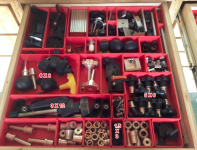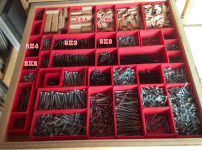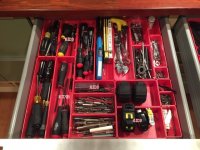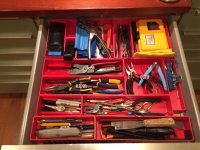Major spring-cleaning over the weekend, this freakish February temps have been up to the 70’s with blue sky and light breezes. About time for the Daffodils to pop up so they can get clobbered by one last blizzard.
Going back to one of the original “guiding principles” for the shop rehab:
If it is not used in the shop, it is not stored in the shop. I updated this to “used frequently” and cleared our stuff like finishes, steam bending equip and so on. The shop is basically down to benches, power and hand tools, clamps, fasteners and fixtures.
[attachimg=1]
I also pulled out seldom-used tools and plan to sell them off, stand by for a few posts in the classifieds.
Upright storage of long/thin stuff is pretty much under control, no more stuff leaning again the walls in a corner.
[attachimg=2]
I’m now trying to shrink down the (4) 24” cabinets by half. 2 contain fasteners and the other 2 are hand tools, drill bits, and misc. supplies. Some of the tools will get incorporated into shallow drawers on the MFT/SYS cart and I can weed out some seldom used fasteners. The real problem is leaving enough worktop for the 4 stationary tools. This has me considering a turntable in the corner.
[attachimg=3]
[attachimg=4]
I’m looking for any input anyone may have who has used a turntable like this, based on the mock up I think I can fit everything on a 36” turntable offset 2” from the walls. I’m planning to keep the underside open so I can roll the tablesaw underneath it.
[attachimg=5]
If I go with the (38”) turntable and reduce the cabinets to 48” I end up with open space around 28” which is the future home of the to-be-acquired AC/DC TIG welder. I lost my little MIG during Sandy and never replaced it, but I am hankering to add some metalwork back into shop capabilities.
The CT/compressor area still looks like a nest of snakes but that can be cleaned up a bit, it is actually pretty functional.
[attachimg=6]
I can actually get to and use the CNC now, and store panel up to 24" by 32" under it, then anything larger against the wall behind it. Should get those slabs done and cleared out this spring.
[attachimg=7]
On a separate topic, I am seriously considering importing a CS 70 to replace the DeWalt saw. I was looking at the ERIKA 75 but given the cost difference I think I can get by with the CS. What I really want is the pull-saw functionality, it will sit on a cart so portability is not important to me. Anyone happy/unhappy with the CS 70?
Thanks,
RMW

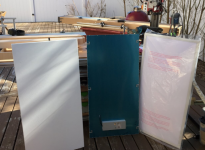
![ScreenClip [5].png](/data/attachments/34/34462-176effbca73f160038faa15b36e3f131.jpg?hash=Dp2-B-pFj4)
![ScreenClip [1].png](/data/attachments/34/34463-826ad1ba8ec4d571df49462d6b109084.jpg?hash=xl8QylE5oP)
![ScreenClip [3].png](/data/attachments/34/34464-f263e782e9ec801b71268b170712087f.jpg?hash=cqH9Fc7wdF)
![ScreenClip [4].png](/data/attachments/34/34465-98281636890e7c32134be02b447a636a.jpg?hash=8c72IqRIZT)
![ScreenClip [6].png](/data/attachments/34/34466-10903b16dc3232edc087139b958c86f9.jpg?hash=89wjpAs35m)
![ScreenClip [5] (Small).png](/data/attachments/34/34778-1cf2662d6304a1a5352a69ae5078f0a6.jpg?hash=uszpif4HI_)
![ScreenClip [2] (Small).png](/data/attachments/34/34777-1d821c2438690dc3540679c01f2f2e91.jpg?hash=XkO8BRI6u5)
![ScreenClip [4] (Small).png](/data/attachments/34/34776-304ed548d8158662936b9c5a8fb6a636.jpg?hash=02r7UqvrDC)
![ScreenClip [1] (Small).png](/data/attachments/34/34775-9f7889f71f5a3e766cf61bb34dce39a4.jpg?hash=3oJ9SAa2WR)
![ScreenClip [7] (Small).png](/data/attachments/34/34774-ddf164b6b4b08742d49a476fc4f76792.jpg?hash=Cgd9dyn876)
![ScreenClip [3] (Small).png](/data/attachments/34/34773-a3c04ecdd94291c648a281ea169f844f.jpg?hash=2hvv7V55ug)
![ScreenClip [8] (Small).png](/data/attachments/34/34771-e3fc9172272a4cf5d173b3f2312d803b.jpg?hash=IztuVMIANe)
